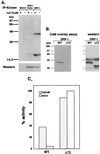Death-associated protein kinase-related protein 1, a novel serine/threonine kinase involved in apoptosis
- PMID: 10629061
- PMCID: PMC85221
- DOI: 10.1128/MCB.20.3.1044-1054.2000
Death-associated protein kinase-related protein 1, a novel serine/threonine kinase involved in apoptosis
Abstract
In this study we describe the identification and structure-function analysis of a novel death-associated protein (DAP) kinase-related protein, DRP-1. DRP-1 is a 42-kDa Ca(2+)/calmodulin (CaM)-regulated serine threonine kinase which shows high degree of homology to DAP kinase. The region of homology spans the catalytic domain and the CaM-regulatory region, whereas the remaining C-terminal part of the protein differs completely from DAP kinase and displays no homology to any known protein. The catalytic domain is also homologous to the recently identified ZIP kinase and to a lesser extent to the catalytic domains of DRAK1 and -2. Thus, DAP kinase DRP-1, ZIP kinase, and DRAK1/2 together form a novel subfamily of serine/threonine kinases. DRP-1 is localized to the cytoplasm, as shown by immunostaining and cellular fractionation assays. It binds to CaM, undergoes autophosphorylation, and phosphorylates an exogenous substrate, the myosin light chain, in a Ca(2+)/CaM-dependent manner. The truncated protein, deleted of the CaM-regulatory domain, was converted into a constitutively active kinase. Ectopically expressed DRP-1 induced apoptosis in various types of cells. Cell killing by DRP-1 was dependent on two features: the status of the catalytic activity, and the presence of the C-terminal 40 amino acids shown to be required for self-dimerization of the kinase. Interestingly, further deletion of the CaM-regulatory region could override the indispensable role of the C-terminal tail in apoptosis and generated a "superkiller" mutant. A dominant negative fragment of DAP kinase encompassing the death domain was found to block apoptosis induced by DRP-1. Conversely, a catalytically inactive mutant of DRP-1, which functioned in a dominant negative manner, was significantly less effective in blocking cell death induced by DAP kinase. Possible functional connections between DAP kinase and DRP-1 are discussed.
Figures








References
-
- Basu S, Kolesnick R. Stress signals for apoptosis: ceramide and c-Jun kinase. Oncogene. 1998;17:3277–3285. - PubMed
-
- Bokoch G M. Caspase-mediated activation of PAK2 during apoptosis: proteolytic kinase activation as a general mechanism of apoptotic signal transduction? Cell Death Differ. 1998;5:637–645. - PubMed
-
- Cardone M H, Salvesen G S, Widmann C, Johnson G, Frisch S M. The regulation of anoikis: MEKK-1 activation requires cleavage by caspases. Cell. 1997;90:315–323. - PubMed
-
- Cardone M H, Roy N, Stennicke H R, Salvesen G S, Franke T F, Stanbridge E, Frisch S, Reed J C. Regulation of cell death protease caspase-9 by phosphorylation. Science. 1998;282:1318–1321. - PubMed
Publication types
MeSH terms
Substances
LinkOut - more resources
Full Text Sources
Other Literature Sources
Molecular Biology Databases
Research Materials
Miscellaneous
